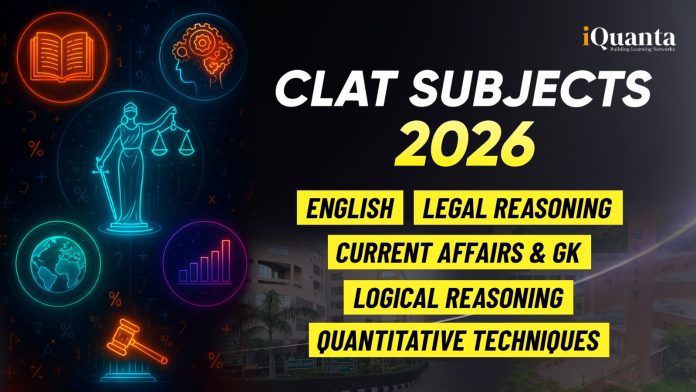In this article, we will delve deeper into the details of CLAT subjects 2026 and section-wise strategy, topics and sub-topics majorly asked in the exam. By the end of this article, you will have a clear understanding of CLAT subjects 2026, its exam pattern and section-wise strategy.
The Common Law Admission Test (CLAT) serves as a centralized national level entrance exam, administered by the consortium of National Law Universities, a collective comprising representative universities. CLAT is a law entrance exam. The CLAT Exam serves as the cornerstone of the admission process for gaining admission in 25 out of 27 National Law Universities (NLUs) across India. Notably, NLU Delhi and NLU Meghalaya conduct their entrance exams. In CLAT exam, there are a total of 5 CLAT subjects 2026 or sections namely, Quantitative Techniques, English Language, Current Affairs, Logical Reasoning and Legal Reasoning.
CLAT Syllabus 2026
| Section | Total Weightage | Syllabus |
Type of Questions
|
| English Language | 20% | 1. Correcting Incorrect Grammar Sentences 2. Synonyms & Antonyms 3. Tenses 4. Fill In The Blanks 5. Spotting Grammatical Errors 6. Active & Passive Voice |
MCQ |
| Current Affairs incl. GK | 25% | 1. Current events (national & international) 2. Awards, Honours 3. Government Schemes 4. Sports 5. History, Polity, Geography (Basic) 6. Arts & Culture |
MCQ |
| Legal Reasoning | 25% | 1. Legal Principles & Application 2. Legal Maxims 3. Constitutional Law 4. Important Judgements 5. Torts, Contracts, Criminal Law (Basic) |
MCQ (Passage-based)
|
| Logical Reasoning | 20% | 1. Logical Sequences 2. Analogies 3. Critical Reasoning 4. Statement-Argument 5. Syllogisms 6. Assumptions and Conclusions |
MCQ (Passage-based)
|
| Quantitative Techniques | 10% | 1. Arithmetic (Ratio, Time, Percentage, SI & CI) 2. Averages 3. Profit & Loss 4. Data Interpretation (Bar Graphs, Tables) 5. Mensuration |
MCQ (Graph/Table based)
|
CLAT Subjects 2026: English Language
The preparation strategy for English Language entails:
-
- Practicing reading diverse passages and understanding their main ideas, tone, and purpose. Focus on improving reading speed and comprehension.
- Brushing up on grammar rules, including parts of speech, sentence structure, and punctuation. Increase your vocabulary by regularly reading newspapers, novels, and magazines—practice exercises on topics like synonyms, antonyms, analogies, and idioms.
CLAT Subjects 2026: General Knowledge & Current Affairs
The preparation strategy for GK and Current Affairs entails:
-
- Staying updated with current affairs by reading newspapers, magazines, and online news portals regularly.
- Covering topics such as politics, economics, international relations, science and technology, sports, awards and honors, etc.
- Making concise notes of important events, dates, and facts to revise regularly.
- Solving previous years’ question papers and mock tests to gauge your preparation level.
CLAT Subjects 2026: Mathematical Techniques
The preparation strategy for Mathematical Techniques entails:
-
- Focusing on topics such as arithmetic, algebra, geometry, and mensuration.
- Understanding basic concepts thoroughly and practice solving problems regularly.
- Working on improving speed and accuracy by practicing with a timer.
- Solving sample papers and previous years’ question papers to get acquainted with the exam pattern and types of questions asked.
CLAT Subjects 2026: Legal Reasoning
The preparation strategy for Legal Reasoning entails:
-
- Understanding the fundamentals of law, including legal principles, concepts, and reasoning.
- Practicing solving legal reasoning questions based on principles, facts, and conclusions.
- Reading legal articles, cases, and judgments to enhance your understanding of legal concepts.
- Solving mock tests and previous years’ question papers to improve your problem-solving skills. :
CLAT Subjects 2026: Logical Reasoning
The preparation strategy for Logical Reasoning entails:
-
- Practicing different types of reasoning questions such as syllogisms, logical sequences, analogies, etc.
- Improving your analytical and critical thinking skills by solving puzzles, brain teasers, and logical reasoning exercises.
- Learning techniques to solve questions quickly and accurately, such as diagramming, making tables, and eliminating answer choices.
CLAT 2026 Exam Pattern
Understanding the CLAT exam pattern for 2026 is important and strategic. The CLAT exam covers five major CLAT subjects 2026 which includes English Language, Current Affairs including General Knowledge, Quantitative Techniques, Logical Reasoning and Legal Reasoning. Each section already has a defined range of questions that contributes to the overall score in the CLAT exam. Familiarity with the subject wise CLAT exam pattern helps CLAT aspirants to prioritize their exam preparation time and approach the CLAT exam with confidence. After understanding the CLAT Subjects 2026, take a look at the CLAT Exam Pattern 2026 below.
| Subjects | Questions |
|---|---|
| English Language | 22-26 Questions |
| Current Affairs/GK | 28-32 Questions |
| Quantitative Techniques | 10-14 Questions |
| Logical Reasoning | 22-26 Questions |
| Legal Reasoning | 28-32 Questions |
CLAT 2026: Exam Dates
Let us dive into the important details to note after understanding the CLAT Subjects 2026. Below are the CLAT exam dates.
| Event | Date (Expected) |
| Registration Starts |
July 2026 (1st week)
|
| Registration Ends |
November 2026 (1st week)
|
| Admit Card Release |
November 2026 (last week)
|
| CLAT 2026 Exam Date |
December 2026 (1st/2nd Sunday)
|
| Result Declaration |
December 2026 (last week)
|
CLAT Subjects 2026: Mock Test Strategy
Mock tests play a very important role in the preparation for all CLAT subjects 2026, as they help CLAT aspirants that simulate the real exam environment and helps you to check in which subjects you want to focus more.
Why Mock Test Matters for CLAT subjects 2026?
- It will help you to develop time management skills.
- Wil improve accuracy and reduce the hassle of making silly mistakes during the CLAT exam.
- Provide you the familiar CLAT exam environment that you will actually face in the future CLAT exam 2026.
- Helps you to identify your weak and strong area and then before appearing for the actual exam, you will able to identify your weak areas and study accordingly without any doubt.
- For the CLAT aspirant who will gonna appear for the first time in the CLAT exam, then with the help of mock tests they will able to understand the questions patterns and marking scheme.
Also Read: CLAT Mock Test
CLAT Subjects 2026 vs AILET 2026 (Expected)
CLAT and AILET both test similar legal aptitude along with the reasoning skills. CLAT subjects include a separate Quantitative Techniques section that requires basic math proficiency.
In contrast, AILET 2026 does not have a math section and is more on legal and logical reasoning. Candidates are preparing for both exams and align their strategies that is based on the subject level differences for optimal results.
|
Feature / Subject
|
CLAT 2026 | AILET 2026 |
| Conducting Body | Consortium of National Law Universities |
National Law University (NLU) Delhi
|
| Mode of Exam | Offline (Pen & Paper) |
Offline (Pen & Paper)
|
| Duration | 2 Hours |
1.5 Hours (90 Minutes)
|
| Total Questions | 120 | 150 |
| English Language | Included (22–26 questions) | Included |
| Current Affairs / GK | Included (28–32 questions) | Included |
| Legal Reasoning | Included (28–32 questions) |
Included (Focus on principles + facts)
|
| Logical Reasoning | Included (22–26 questions) |
Included (Expanded section)
|
| Quantitative Techniques | Included (10–14 questions) | Not Included |
| Math in AILET? | No separate section |
No direct math section
|
| Negative Marking | -0.25 for every incorrect answer |
-0.25 for every incorrect answer
|
CLAT 2026 Marking Scheme
There are a total of 120 questions in the CLAT exam. If the students take the CLAT exam, they must remember the marking scheme of the exam. For every correct answer, the student will be awarded +1 marks. For every incorrect answer, the student will face a penalty or will incur a negative marking of -0.25 marks. If any question is left Unattempted, there will be no marking, i.e. 0.
| Response | Marks |
| Correct Answer | +1 Marks |
| Incorrect Answer | -0.25 Marks |
| Unanswered/Unattempted | 0 Marks |
CLAT subjects 2026 with key topics
In this section we have combined the CLAT subjects, about their weightage and what are the key topics according to the particular CLAT subjects that CLAT aspirant need to focus on while building strategy and start preparing for the exam. This table gives the comprehensive view to the aspirants that helps them prepare in a positive manner.
| CLAT Subjects | Weightage (Approx.) | Key Topics |
| English Language | 20% |
Reading Comprehension, Grammar, Synonyms & Antonyms, Tenses, Error Spotting, Fill in the Blanks
|
| Current Affairs / GK | 25% |
National & International Events, Awards & Honours, Government Schemes, Sports, Art & Culture, Summits, History
|
| Quantitative Techniques | 10% |
Ratios & Proportions, Basic Algebra, Mensuration, Statistical Estimation, Arithmetic
|
| Logical Reasoning | 20% |
Analogies, Series, Blood Relations, Syllogisms, Logical Sequences, Seating Arrangements, Calendars
|
| Legal Reasoning | 25% |
Law of Torts, Contract Act, IPC, Constitution, Legal Maxims, Legal Principles, Case-based Questions, Public International Law
|
Also Read: CLAT Previous Years Question Papers
Best CLAT Coaching
After understanding the CLAT subjects 2026, its exam pattern, and the full syllabus, the main question that arises is “Where to Prepare from?” The simple answer is iQuanta! Enroll now and be a part of the winning clan. Prepare for CLAT 2026 with iQuanta!!
Click on the banners below or visit iQuanta’s CLAT website

CLAT Subjects 2026: FAQs
Which stream is best for CLAT?
The humanities stream suits the exam’s reading-intensive nature, but the science and commerce streams also come with their benefits. The optimal choice depends on your skills and long-term objectives. Select a stream that aligns with your strengths and provides a solid foundation for your intended areas of law.
Does 12th marks matter in CLAT?
CLAT admission primarily depends on CLAT scores. however, Class 12th marks are important as they must meet the minimum eligibility criteria (45% for general and 40% for SC/ST).
Is CLAT tough to clear?
Yes, it can be challenging keeping in mind the CLAT Subjects 2026, but with the right approach and preparation, it is definitely achievable. While the CLAT is undeniably tough, a combination of thorough preparation, strategic planning, and a positive mindset can make it a realistic and attainable goal for aspiring law students.

Can I become a lawyer without CLAT?
If you’re considering pursuing a law degree in India but prefer to avoid the CLAT exam or are intimidated by CLAT Subjects 2026, there are several reputable alternatives available. Institutions such as SRM University, GITAM University School of Law, Banasthali Vidyapith, ICFAI Law School, and KL University are among the top choices.
What is the age limit of CLAT law?
According to the official eligibility criteria for CLAT 2026, there is no age limit for candidates appearing in the CLAT UG or CLAT PG exams. However, candidates must meet the other basic educational requirements to participate in the CLAT Exam 2026.
What are the main CLAT subjects for 2026?
The five main CLAT subjects 2026 are Current Affairs including General Knowledge, English language, Quantitative Techniques, Logical Reasoning and Legal Reasoning.
Are CLAT subjects the same every year?
The core CLAT subjects remain the same every year but some question patterns and difficulty level may vary slightly.
Does CLAT 2026 have negative marking?
Yes all CLAT subjects 2026 carry negative marking there is some deduction of 0.25 in marks for each incorrect answers.
Which CLAT subject carries the highest weightage in the exam?
Current Affairs/GK and Legal Reasoning are the most heavily weighted CLAT subjects in 2026 and each subject is accounting for approximately 25% of the paper.
How many questions are asked from each CLAT subjects?
Here is the list of CLAT subjects with number of questions per subjects.
- English Language: 22–26 questions
- GK/Current Affairs: 28–32 questions
- Quantitative Techniques: 10–14 questions
- Logical Reasoning: 22–26 questions
- Legal Reasoning: 28–32 questions





